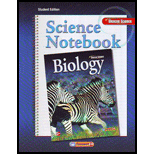
Concept explainers
To classify:
Each term as central nervous system or peripheral nervous system.
Introduction:
The nervous system is found in animal body that helps in the coordination of behavior and transmission of signals between different areas of body. In vertebrates, nervous system is divided into the peripheral nervous system and the central nervous system.
Explanation of Solution
Central nervous system Central nervous system consists of the brain and the spinal cord mainly. The brain is center of our thoughts, controls our body movement, and interpret the information from the external and internal environment. Some reflex movements occur via the spinal cord.
Cerebrum − It is the uppermost portion of the brain. It functions to receive sensory information and controlling the body.
Hypothalamus − It is a part of the brain that contains many small nuclei that performs many functions. Its main function is to link the nervous system and the endocrine gland, by the help of pituitary gland.
Medulla oblongata − The medulla oblongata is the lower portion of the brain stem. It performs involuntary functions of the body.
Pons − The pons are found between the midbrain and the medulla oblongata. It has tracts that transport signal to the cerebellum and the medulla from the cerebrum.
Peripheral nervous system This type of nervous system contains all the neurons and nerves that are present outside the central nervous system. The main function of the PNS is to connect other boy organs to the CNS.
Autonomic nervous system −This is mainly involuntary nervous system that controls all the functions of the body like digestion, respiration, papillary action, and urination.
Parasympathetic nervous system − It is completely involuntary nervous system. It cannot be controlled by one’s will. This nervous system helps in the conservation of energy by slowing the heart rate, increasing intestinal activity, and relaxing the GI tract.
Somatic nervous system − This nervous system controls the voluntary actions like body movement with the help of skeletal muscles. This nervous system contains sensory nerves and motor nerves.
Sympathetic nervous system − This nervous system directs involuntary response during stressful directions. It increases the heart rate, and increases blood flow in the body.
Chapter 33 Solutions
Biology Science Notebook
Additional Science Textbook Solutions
Human Physiology: An Integrated Approach (8th Edition)
Fundamentals of Anatomy & Physiology (11th Edition)
Brock Biology of Microorganisms (15th Edition)
Campbell Biology in Focus (2nd Edition)
Anatomy & Physiology
Brock Biology of Microorganisms (14th Edition)
 Human Anatomy & Physiology (11th Edition)BiologyISBN:9780134580999Author:Elaine N. Marieb, Katja N. HoehnPublisher:PEARSON
Human Anatomy & Physiology (11th Edition)BiologyISBN:9780134580999Author:Elaine N. Marieb, Katja N. HoehnPublisher:PEARSON Biology 2eBiologyISBN:9781947172517Author:Matthew Douglas, Jung Choi, Mary Ann ClarkPublisher:OpenStax
Biology 2eBiologyISBN:9781947172517Author:Matthew Douglas, Jung Choi, Mary Ann ClarkPublisher:OpenStax Anatomy & PhysiologyBiologyISBN:9781259398629Author:McKinley, Michael P., O'loughlin, Valerie Dean, Bidle, Theresa StouterPublisher:Mcgraw Hill Education,
Anatomy & PhysiologyBiologyISBN:9781259398629Author:McKinley, Michael P., O'loughlin, Valerie Dean, Bidle, Theresa StouterPublisher:Mcgraw Hill Education, Molecular Biology of the Cell (Sixth Edition)BiologyISBN:9780815344322Author:Bruce Alberts, Alexander D. Johnson, Julian Lewis, David Morgan, Martin Raff, Keith Roberts, Peter WalterPublisher:W. W. Norton & Company
Molecular Biology of the Cell (Sixth Edition)BiologyISBN:9780815344322Author:Bruce Alberts, Alexander D. Johnson, Julian Lewis, David Morgan, Martin Raff, Keith Roberts, Peter WalterPublisher:W. W. Norton & Company Laboratory Manual For Human Anatomy & PhysiologyBiologyISBN:9781260159363Author:Martin, Terry R., Prentice-craver, CynthiaPublisher:McGraw-Hill Publishing Co.
Laboratory Manual For Human Anatomy & PhysiologyBiologyISBN:9781260159363Author:Martin, Terry R., Prentice-craver, CynthiaPublisher:McGraw-Hill Publishing Co. Inquiry Into Life (16th Edition)BiologyISBN:9781260231700Author:Sylvia S. Mader, Michael WindelspechtPublisher:McGraw Hill Education
Inquiry Into Life (16th Edition)BiologyISBN:9781260231700Author:Sylvia S. Mader, Michael WindelspechtPublisher:McGraw Hill Education





